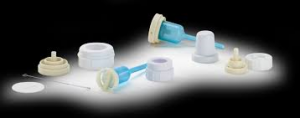Why, WHY, do these baby bottles have to come with so many pieces?? I feel like I’m doing dishes all day.
I try to narrate what I’m doing to my baby throughout the day, and I don’t even know what to call all of the bottle parts—there’s the blue thing (the tube that goes into the milk), the off-white plug thing that goes into the top of blue thing, the white ring that goes around the base of the nipple, the nipple and the bottle.
There has to be a reason–all this assembly and dish-washing has to be for a reason. I decided to investigate.
The most obvious effect, which one could guess at or observe is that the blue thing, called the vent reservoir, helps to eliminate vacuum pressure. As the baby drinks from the bottle there’s less and less milk inside the bottle, would create vacuum. Think of it this way—if you turned a water bottle upside down, after some water poured out, you’d get quick bursts of air bubbles rushing into the bottle creating a “glug glug glug” effect.
Instead, with a baby bottle, air can enter through the blue tube, into the bottle to fill the vacuum. Since the air can gently continuously flow in, this prevents the sudden bursts of air otherwise causing the “glug glug”. This makes it easier to drink and more like breastfeeding.
So if air’s coming in through the blue tube, how does milk get out? The milk flows around the outside of the blue venting system, and into the holes in the off-white plug thing that goes into the top of the blue venting system, called the vent insert. The vent insert has holes in it, allowing the milk to flow into the nipple.
Another effect of the blue tube is that it’s long enough that it prevents air from passing through the milk, on its way, reducing aeration of the milk. Less aeration of the milk means less gas consumed by the baby, which means less gas that needs to come out with a burp. Or out the other end. In theory, this means less colic, spit-up, burping and gas.
The white ring simply holds the nipple onto the bottle and creates a seal with the venting system, in place.
Last, since air isn’t flowing through the milk, this system also reduces milk oxidation, which can deteriorate nutrients, such as vitamin C, A and E. So the milk the baby gets more vitamins.
OK, well, after investigating, I still feel like a dish-washing zombie. At 13-months-old, we’re long past the age of colic or lots of spit-ups, but I’m sure my baby appreciates feeling less gassy. And, it’s good to know that I’m actually giving her better milk because of all of these parts. And, bonus, as I narrate to my baby, now I can say things like “vent insert” instead of “the off-white plug thing”.
If you want to receive Mama Lovejoy articles automatically through your Facebook feed you can, by liking the Mama Lovejoy Facebook page.

Thanks for bringing me up to date. Sounds like dishwashing chores are all in manual. Yuk! .